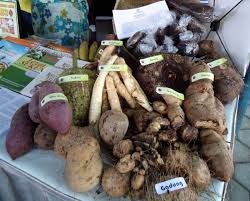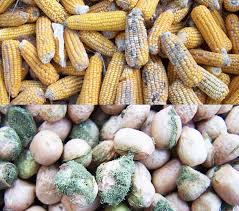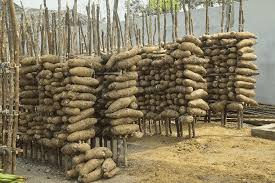Losses occur at all stages from the field to the consumer’s table. Losses happen during harvest, transportation to markets, and processing. At each stage, various factors cause losses.
These may be due to external agents such as insects and other predators, physical factors like handling, transportation, and storage conditions, or other physical causes. These are all challenges related to storage. The problems of traditional storage are explained below:
Disease and Pest Problems Affecting Storage of Roots and Tubers
Disease and pests significantly reduce the yields of roots and tubers, accelerating deterioration during storage. For example, cassava is adversely affected by pests like the cassava mealybug (Phenacoccus manihoti) and green spider mite (Mononychellus species).
Yams suffer from nematodes, yam beetles, leaf spot, and viral diseases. Similarly, cocoyams are vulnerable to blight, while sweet potato yields decline when attacked by viruses, root knot nematodes, and the sweet potato weevil.
Labour Shortage During Harvest and Storage of Roots and Tubers
Labour shortages often worsen due to the seasonal nature of operations. The division of labour is high, and only a few workers are available during peak periods.
Read Also: Are Honey Bees Aggressive?
Post-Harvest Technology Challenges in Handling Roots and Tubers

Roots and tubers present challenges due to their bulkiness, making transportation and handling difficult. Their perishability causes problems during storage.
Since these crops have low protein content, processing is necessary to enhance their use, especially in composite flours. Suitable methods and equipment are needed to ensure their availability in urban areas throughout the year.
Socio-Economic Constraints Affecting Roots and Tubers Production and Storage
Roots and tubers experience bias in research, extension services, resource allocation, and consumption because they are considered “poor people’s crops” and seen as lower in status compared to cereal staples.
This bias leads to shifts among higher-income or urban populations toward cereals. The easier storage and handling of cereals further increase their demand. Roots and tubers participate only slightly in international and inter-regional trade, limiting their movement from surplus to deficit areas.
Price and Marketing Problems of Roots and Tubers
Marketing issues include the collection and handling of bulky, small quantities of irregularly supplied produce with high water content and perishability. These products pass through long marketing chains involving several intermediaries and varying periodic markets.
The lack of an adequate marketing organization forces farmers to accept low prices offered at the farm gate or local markets by middlemen, who process and transport goods to urban centers.
Consequently, farmers receive only a small fraction of the final price. Policy constraints in many countries favor cereals over roots and tubers, partly due to poor traditional storage methods for these crops.
Improved Storage Methods for Roots and Tubers
Improved storage methods for fresh cassava include freezing, gamma irradiation, control of storage environment (relative humidity and temperature), and waxing, although many of these techniques have not been fully tested.
Three tested improved methods are:
- dipping fresh tubers in fungicide and packing them in polyethylene bags,
- storing in specially prepared trenches
- storing in moist sawdust.
These methods, while not yet widely used, are useful for small and medium-scale cassava production.
Storage of Roots and Tubers in Polyethylene Bags
This simple storage method can extend shelf life to two weeks or more if done properly. It is based on the principle of “curing,” where the tuber forms a new layer of cells over damaged tissue.
Freshly harvested roots are treated with a 0.4% solution of Mertect, a thiabendazole-based fungicide. The tubers are then packed and sealed in polyethylene bags.
Inside the bags, the tubers maintain a temperature between 30°C and 40°C with relative humidity above 80%. The fungicide prevents microorganism growth in this humid environment.
Storage of Roots and Tubers in Trenches
This low-cost method, developed by the Nigerian Stored Products Research Institute, keeps cassava fresh for 6 to 8 weeks. It is easy for farmers and processors to implement.
A trench is dug at a site with a low water table to prevent seepage. The trench should measure 2 meters long, 1.5 meters wide, and 1 meter deep. Depending on tuber size, this trench can store between 0.5 and 0.7 tons of cassava.
Read Also: Recommended Number of Ruminant Animals per Housing Unit for Fattening
Agents and Causes of Deterioration of Stored Agricultural Foods

Stored foods face deterioration caused by several biological agents, including:
- micro-organisms (fungi, bacteria, and yeasts)
- arthropods (insects and mites), and
- rodents (rats and mice). These agents cause significant damage to stored produce. While improved storage methods reduce losses, pests may still access stored commodities, especially in tropical regions where storage structures are inadequate. Spoilage rates can increase due to climatic, technical, or economic factors.
Many insect and mite species exist in stored produce, but only a few cause economic damage. Some are beneficial predators and parasitoids attacking harmful pests.
The two major insect pest groups are beetles and moths, which undergo complete metamorphosis, meaning larval forms differ greatly from adults.
Non-Biological Causes of Deterioration in Stored Agricultural Products
Non-biological causes include physical factors such as temperature, humidity, moisture, and gases, which influence the physiological activities of storage pests.
These factors depend on storage conditions, methods, duration, and product state (whether broken or contaminated with impurities).
Physical Properties of Agricultural Commodities Influencing Storage
These properties include free moisture content, specific heat, and thermal conductivity, which determine storability.
Water content in grains and seeds exists as water of composition within plant cells and free water on cell surfaces. Free moisture content is crucial for storage ability; for example, cereals and legumes do not store well if moisture exceeds 13% and 15%, respectively.
Maximum Moisture Content for Long-Term Storage of Grains
Groundnuts – 7%
Rice – 13%
Sorghum – 12.5%
Paddy Rice – 14%
Wheat – 13%
Pulse – 15%
Maize – 13%
Millet – 16%
Thermal Conductivity and Its Effect on Storage
Food grains have low specific heat and low thermal conductivity, meaning they heat up quickly but lose heat slowly. If grains or seeds heat internally, natural air movement is insufficient to cool them.
This increase in temperature boosts pest activity and encourages mold growth, causing rapid deterioration of the commodity.
Do you have any questions, suggestions, or contributions? If so, please feel free to use the comment box below to share your thoughts. We also encourage you to kindly share this information with others who might benefit from it. Since we can’t reach everyone at once, we truly appreciate your help in spreading the word. Thank you so much for your support and for sharing!

